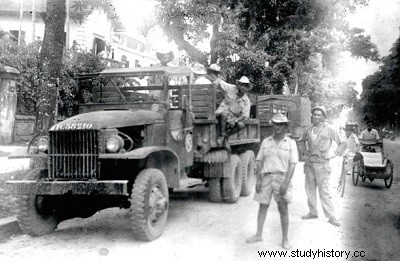
The Charton column:a disparate convoy
Cao Bang, October 3, 6 am. The fifteen outposts of the hedgehog defending the city are abandoned one after the other. The last position evacuated, the 150 tons of ammunition stored in the Citadel jump. It is a disparate convoy that engages on the R.C.4. The troops. first of all. Charton describes them as follows:
• A battalion of loyal partisans, but poorly seasoned and poorly supervised, with the exception of two good company commanders. Two hundred partisans had hardly ever held a gun. Very old on the whole, they were employed as masons. bakers, butchers.
• A Legion battalion, the 3/3' R.E.I., comprising only 600 men and whose officers, completely renewed, have never left France or Germany only a month ago. They had absolutely no knowledge of the region and were unaware of any combat in the Upper Region.
.The 3' Tabor, which I had under my command. was the best I had ordered. However, like all Tablars. it was not fleshed out in European cadres. barely a Frenchman per section.
aie finally had an engineer combat section and an artillery section, both excellent. »
But that's not all. Women, children, the sick and the elderly were, in large part. evacuated by the planes which brought the Y Tabor. However, there are still five to six hundred adult macaws in Cao Bang after the last plane took off.
It is inconceivable to abandon them, due to their loyalty to France and communist threats.
Between Cao Bang and Dong Khé, the land consists of steep peaks covered with dense forests. Ambush is possible everywhere. But the road is passable up to km 18. Despite the risk of ambush, Charton decides to use his trucks until then. They allow him to lighten the load of men by transporting half a unit of fire and a day's worth of food. They also allow the transport of the sick - there are some from the first day. The leader of the group can also bring a 105 and a 37 cannon, weapons that could play a crucial role in forcing the passage in the ambush zone which goes from km 18 to km 22, where the Lepage column must collect the grouping.
“When we arrive at km 18, thinks Charton, if the connection with the Lepage column is not made, we will blow up the equipment. If Lepage is there, he will decide whether to pass the material or destroy it. »
The column moves on. The 3' Tabor opens the road up to km 7, relayed by the partisans up to km 12. They push a company up to km 18 on a peak which commands km 22.
When night falls, the 3' battalion of the 3' R.E.I. opened the road only up to km 15 whereas, according to the orders, it should have opened up to km 22. Thus, on the evening of October 3, a company of partisans bivouacked at km 18, the P.C. Charton is installed at km 16, tabors and paratroopers camp at km 15, civilians, cars, engineers and artillery at km 14.
Despite the enemy silence - a few bursts of automatic weapons around km 10 - the progress, already, was too slow. But it was elsewhere that the drama began.
